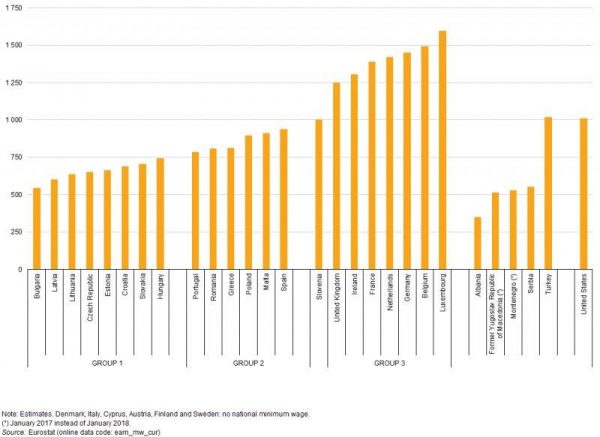 Following the systematic increases in recent years and the transfer of contributions from the employer to the employee, Romania has surpassed Lithuania in terms of minimum gross wage and went up to the 18th position out of 28 EU states in terms of its purchasing power, if the value is adjusted to local prices.
Following the systematic increases in recent years and the transfer of contributions from the employer to the employee, Romania has surpassed Lithuania in terms of minimum gross wage and went up to the 18th position out of 28 EU states in terms of its purchasing power, if the value is adjusted to local prices.
According to the data published by Eurostat, in January we have reached a minimum gross salary of EUR 408, compared to EUR 261 in Bulgaria and EUR 400 in Lithuania.
We have come close to our colleagues in the eastern bloc: Latvia (EUR 430), Hungary (EUR 445), Croatia (EUR 462), the Czech Republic (EUR 478), Slovakia (EUR 480), Estonia (EUR 500) and Poland (EUR 503).
See the graph:
 Minimum wages in the EU, 2018: Attention – Romania is the only EU state with all contributions paid from gross wage
Minimum wages in the EU, 2018: Attention – Romania is the only EU state with all contributions paid from gross wage
For reference, we mention that the UK (EUR 1,401), Germany and France (EUR 1,498, each), Belgium (EUR 1,563), the Netherlands (EUR 1,578), Ireland (EUR 1,641) and Luxembourg (1,999 euro) are over the EUR 1,400 monthly threshold. To keep in mind, in the United States, the gross minimum wage is significantly lower (EUR 1,048 at the exchange rate of January 2018).
Among the group of Western developed countries in the northern part of the continent and the group of former socialist countries that joined the European Union, there is a group of five states in the southern flank where the minimum wage ranges between almost EUR 700 and EUR 900 per month: Portugal (EUR 677), Greece (EUR 684), Malta (EUR 748), Slovenia (EUR 843, the big exception of the eastern bloc) and Spain (EUR 859).
If we adjust to the price level in each country, we obtain the purchasing power of each gross minimum wage mentioned above at the standard purchasing power parity (abbreviated PPS), which means the equivalent level of this salary related to the EU average prices.
Based on this approach, which allows the comparability in terms of living standards offered by the minimum wage, Romania goes up on the 18th position.
Attention! It should be mentioned that this is about the GROSS value of the salary and we are the only country in the EU where almost all contributions paid to the state are deducted from this gross wage and reduce the net more than in other legislation.
However, if we look from the Eurostat’s perspective, Romania leaves behind the group of countries with the lowest minimum wages, below the EUR 750 threshold (Bulgaria, the Baltic countries, the Czech Republic, Slovakia, Croatia and Hungary) and goes up to group 2, between Portugal and Greece, close to the trio of Poland, Malta and Spain.
It is worth noting that Slovenia has already approached group 3, the countries with the highest minimum wages in terms of purchasing power. Also, Belgium takes the leader chair (we ignore the special situation in Luxembourg) based on slightly lower prices than in Germany, the Netherlands or France.
The same prices that compress the gap at the European level from almost 8 to 1 in euros to only 3 to 1 when it comes to the actual purchasing power (the Luxemburg – Bulgaria score drops dramatically from EUR 1,999 – EUR 261 to just EUR 1,597 – EUR 546 in PPS terms).
See the graph:
 Purchasing power of gross minimum wage, 2018
Purchasing power of gross minimum wage, 2018
Unfortunately, one of the obvious effects of this statistical compression is the solution found by a large part of the workforce from the eastern and southern part of the continent if these people have the possibility and want to support their families: to earn however less money in the West but spend it as much as possible at home.
That, along with the low birth rate based on the Western cultural model and the many problems in public services, explains the relatively high depopulation rate of the poorest countries in the EU, Bulgaria and Romania. As well as the amounts sent home, which in turn, also bring the unfavourable effect on the quantity and quality of the local workforce, even in the case of a consistent increase in the minimum wage.
Finally, let’s see how the national minimum wage in Romania has rapidly grown in recent years but still with little effect on preserving the workforce (and, an acute phenomenon, on finding new employees for the developing businesses). A wage that reached over 45% of the national average pay forecasted for this year and covers (officially) almost half of the workforce.
*
Evolution of the national minimum wage in Romania
Semester
Minimum gross wage
*










